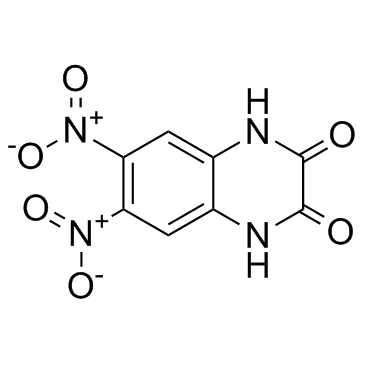DNQX

DNQX structure
|
Common Name | DNQX | ||
|---|---|---|---|---|
| CAS Number | 2379-57-9 | Molecular Weight | 252.141 | |
| Density | 1.7±0.1 g/cm3 | Boiling Point | 670.7ºC at 760 mmHg | |
| Molecular Formula | C8H4N4O6 | Melting Point | >300°C | |
| MSDS | USA | Flash Point | 359.4ºC | |
|
Ammonium increases Ca(2+) signalling and upregulates expression of Cav1.2 gene in astrocytes in primary cultures and in the in vivo brain.
Acta Physiol. (Oxf.) 214 , 261-74, (2015) The primary aim of this study was to identify the effects of hyperammonaemia on functional expression of Cav1.2 L-type Ca(2+) channels in astroglia.Primary cultures of mouse astrocytes were used to study effects of chronic treatment (1-5 days) with ammonium c... |
|
|
Phasic, nonsynaptic GABA-A receptor-mediated inhibition entrains thalamocortical oscillations.
J. Neurosci. 34(21) , 7137-47, (2014) GABA-A receptors (GABA-ARs) are typically expressed at synaptic or nonsynaptic sites mediating phasic and tonic inhibition, respectively. These two forms of inhibition conjointly control various network oscillations. To disentangle their roles in thalamocorti... |
|
|
Abnormal excitability and episodic low-frequency oscillations in the cerebral cortex of the tottering mouse.
J. Neurosci. 35(14) , 5664-79, (2015) The Ca(2+) channelopathies caused by mutations of the CACNA1A gene that encodes the pore-forming subunit of the human Cav2.1 (P/Q-type) voltage-gated Ca(2+) channel include episodic ataxia type 2 (EA2). Although, in EA2 the emphasis has been on cerebellar dys... |
|
|
Enhanced GABAA-Mediated Tonic Inhibition in Auditory Thalamus of Rats with Behavioral Evidence of Tinnitus.
J. Neurosci. 35 , 9369-80, (2015) Accumulating evidence suggests a role for inhibitory neurotransmitter dysfunction in the pathology of tinnitus. Opposing hypotheses proposed either a pathologic decrease or increase of GABAergic inhibition in medial geniculate body (MGB). In thalamus, GABA me... |
|
|
Toll-like receptor 4 enhancement of non-NMDA synaptic currents increases dentate excitability after brain injury.
Neurobiol. Dis. 74 , 240-53, (2015) Concussive brain injury results in neuronal degeneration, microglial activation and enhanced excitability in the hippocampal dentate gyrus, increasing the risk for epilepsy and memory dysfunction. Endogenous molecules released during injury can activate innat... |
|
|
Intrinsic excitability varies by sex in prepubertal striatal medium spiny neurons.
J. Neurophysiol. 113(3) , 720-9, (2015) Sex differences in neuron electrophysiological properties were traditionally associated with brain regions directly involved in reproduction in adult, postpubertal animals. There is growing acknowledgement that sex differences can exist in other developmental... |
|
|
Trans-synaptic zinc mobilization improves social interaction in two mouse models of autism through NMDAR activation.
Nat. Commun. 6 , 7168, (2015) Genetic aspects of autism spectrum disorders (ASDs) have recently been extensively explored, but environmental influences that affect ASDs have received considerably less attention. Zinc (Zn) is a nutritional factor implicated in ASDs, but evidence for a stro... |
|
|
Traumatic Brain Injury Increases Cortical Glutamate Network Activity by Compromising GABAergic Control.
Cereb. Cortex 25 , 2306-20, (2015) Traumatic brain injury (TBI) is a major risk factor for developing pharmaco-resistant epilepsy. Although disruptions in brain circuitry are associated with TBI, the precise mechanisms by which brain injury leads to epileptiform network activity is unknown. Us... |
|
|
Activity-dependent differences in function between proximal and distal Schaffer collaterals.
J. Neurophysiol. 113 , 3646-62, (2015) Axon conduction fidelity is important for signal transmission and has been studied in various axons, including the Schaffer collateral axons of the hippocampus. Previously, we reported that high-frequency stimulation (HFS) depresses Schaffer collateral excita... |
|
|
Postsynaptic mGluR5 promotes evoked AMPAR-mediated synaptic transmission onto neocortical layer 2/3 pyramidal neurons during development.
J. Neurophysiol. 113(3) , 786-95, (2015) Both short- and long-term roles for the group I metabotropic glutamate receptor number 5 (mGluR5) have been examined for the regulation of cortical glutamatergic synapses. However, how mGluR5 sculpts neocortical networks during development still remains uncle... |